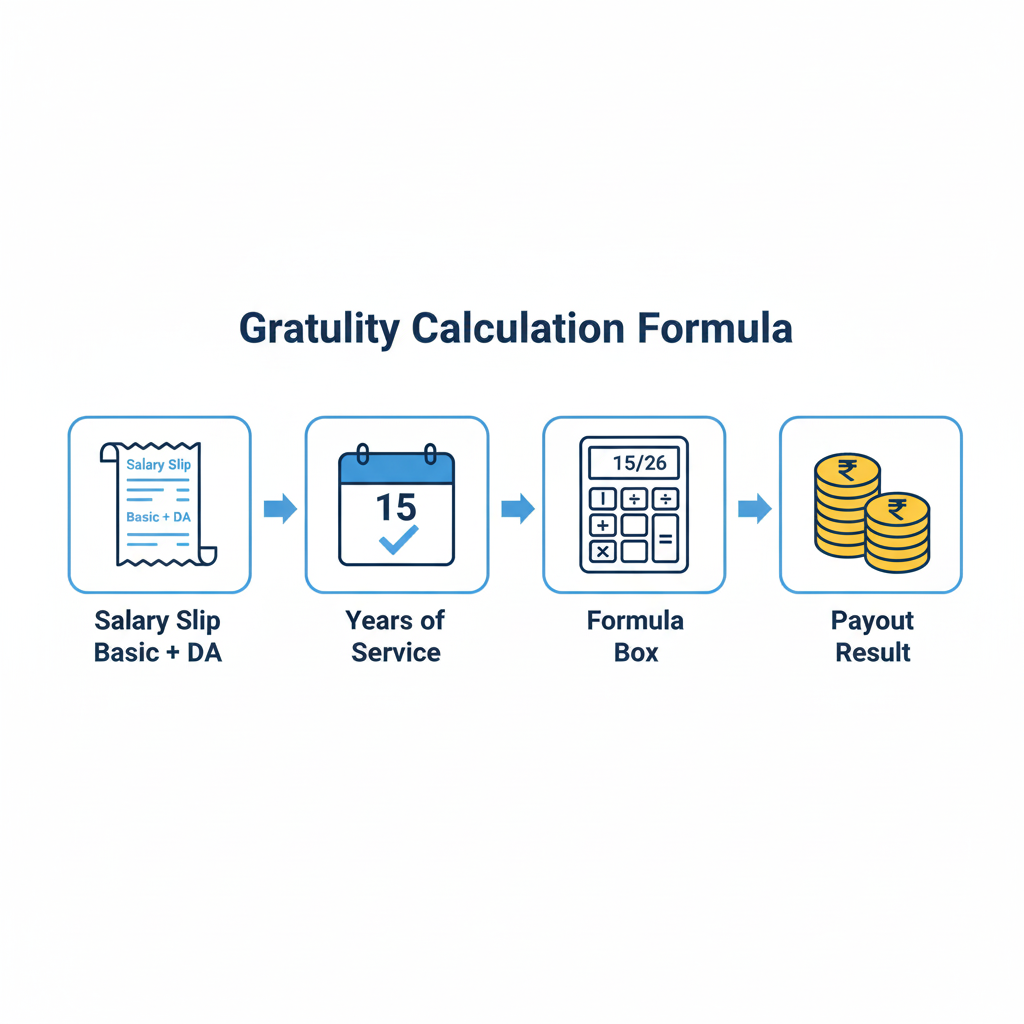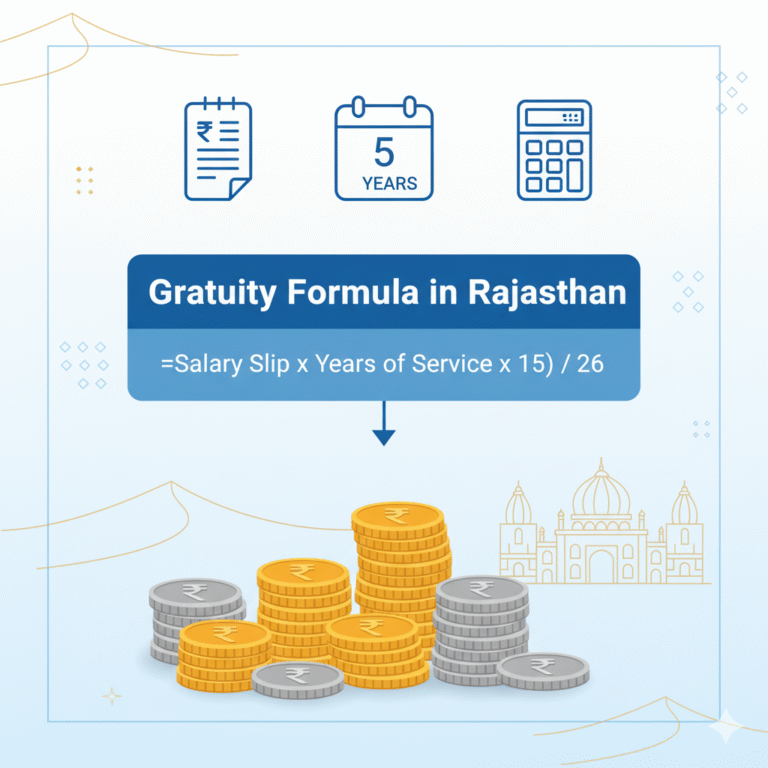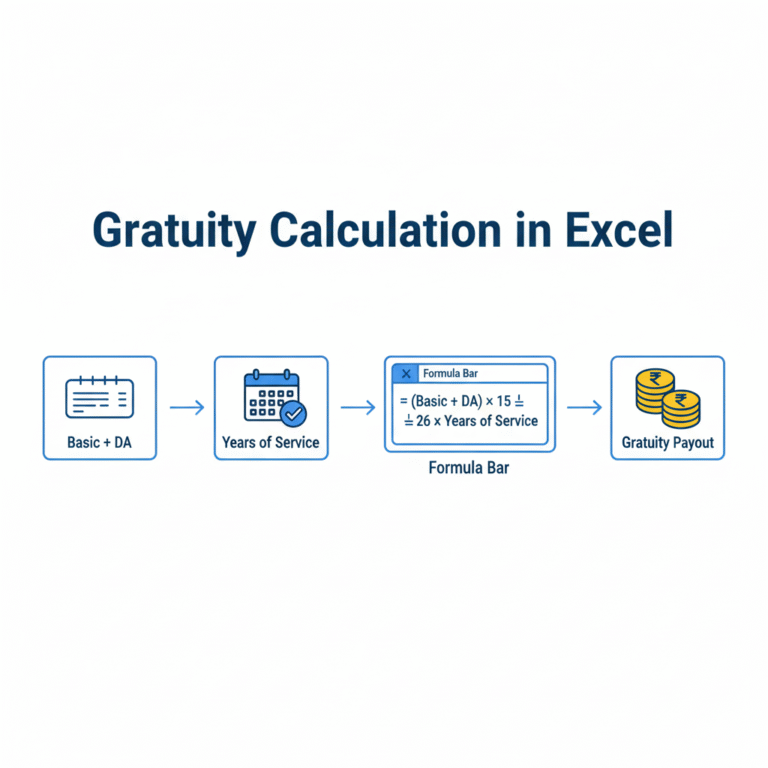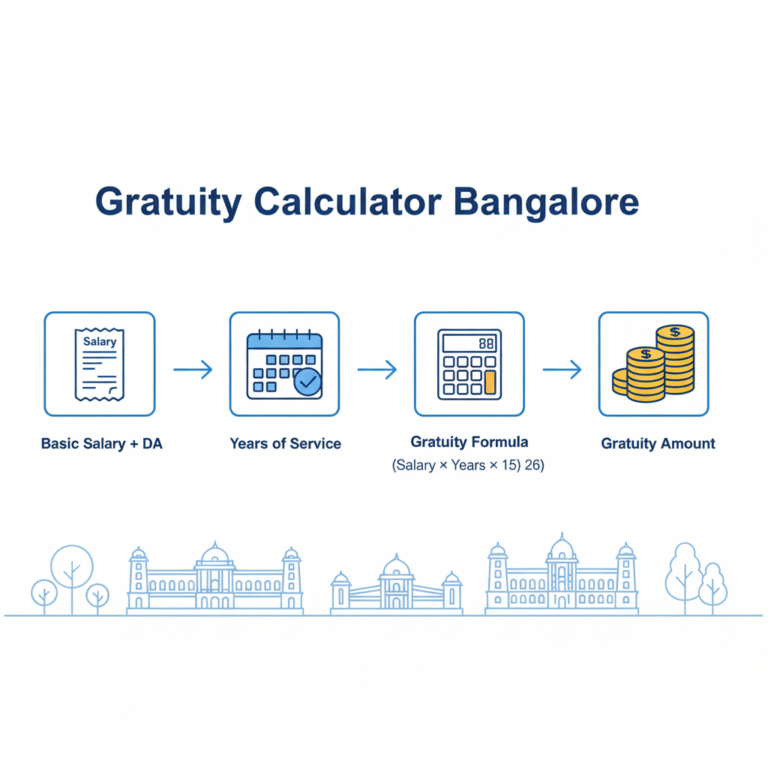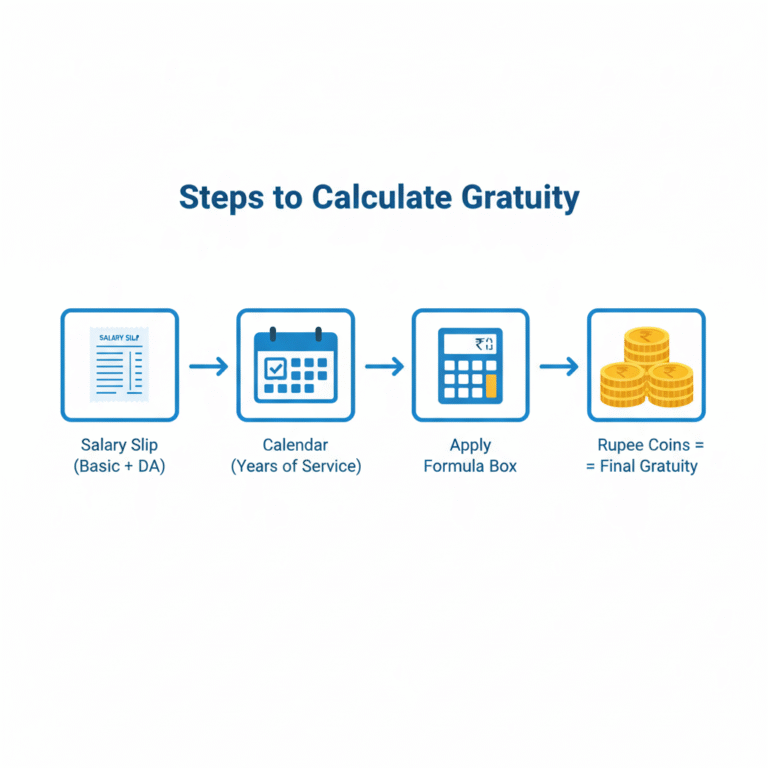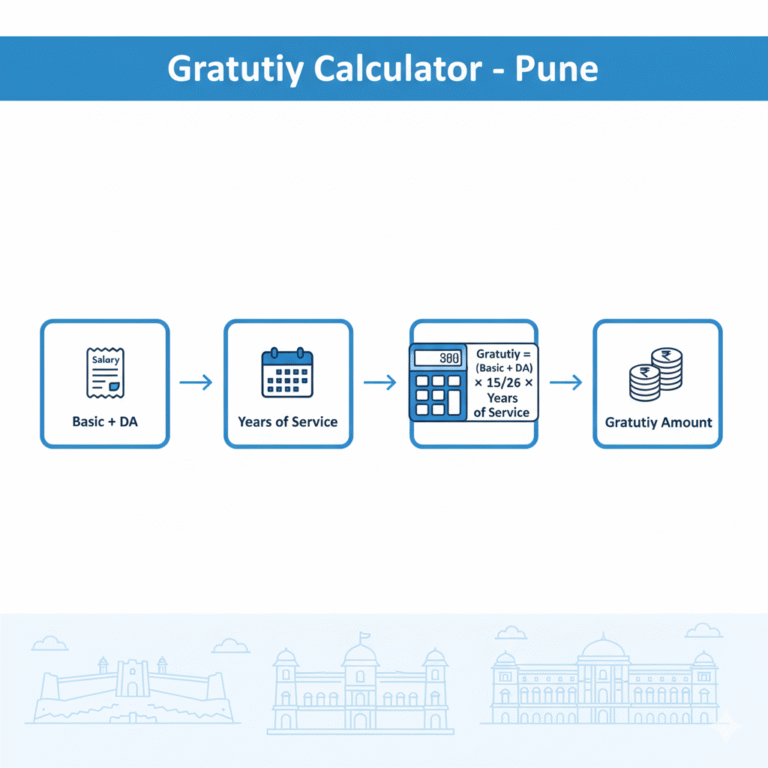Gratuity Calculation Formula – Step-by-Step Guide with Examples
Gratuity is that one-time lump-sum payment many employers give to employees when their time with the company wraps up after a certain period. In India, it’s all laid out in the Payment of Gratuity Calculation Formula Act, 1972, which covers who qualifies, how to calculate it, when it has to be paid, and protections for everyone involved. Whether you’re an HR pro, handling finances, or an employee thinking about your next move, getting the hang of the gratuity formula—and all the little details that tweak the final amount—can help you save cash, avoid arguments, and stay on the right side of the rules.
This guide breaks it down in a straightforward, hands-on way. We’ll walk through the formula, explain what counts in your last salary, how to handle rounding and partial years, and even touch on taxes. You’ll get step-by-step examples, some trickier situations, and a handy FAQ for those quick lookups.
What Gratuity Calculation Formula Means and Why It Matters
Gratuity is basically a legal “thanks a lot” for sticking around and giving your best over the years. It’s an end-of-service perk, often called a retirement bonus, final dues, or severance pay in casual chats. For you as an employee, it provides a financial cushion during job changes, retirement, or unexpected twists. For employers, handling it right builds loyalty, cuts down on legal headaches, and shows you’re running a solid, employee-friendly operation.
Under Indian law, you get Gratuity Calculation Formula when you superannuate, retire, resign, pass away, or become disabled— as long as you’ve met the service requirements in the Act. If the Act covers your workplace, bosses have to stick to its rules, formula, and limits. Even if it doesn’t apply, lots of companies still offer gratuity through their policies or contracts, often following the same basic ideas to keep it fair and straightforward.
Eligibility: The Quick View
Most employees qualify for Gratuity Calculation Formula after five full years of continuous service with the same employer. But there’s a big exception: if it’s due to death or disablement, you don’t need those five years—gratuity is payable no matter how long you’ve been there. This comes straight from Section 4 of the Payment of Gratuity Act, including the part that waives the five-year rule for those tough cases.
The law defines “continuous service” in a real-world way. It includes paid leave, some layoff periods, and approved absences as if you were actually working. This setup makes sure you don’t lose out just because of normal breaks in the routine.
Where the Act Applies and Why Coverage Matters
The Payment of Gratuity Calculation Formula Act kicks in for factories, mines, oilfields, plantations, ports, railways, and shops or commercial spots with ten or more employees on any day in the last 12 months. Once you’re covered, you stay under the Act even if your team shrinks below ten later on. This cutoff is key because it means the formula, rounding rules, and deadlines we talk about are non-negotiable for those employers.
If your company isn’t covered, many still pay Gratuity Calculation Formula as part of their own policies. In those cases, the formula depends on your company’s rules or contract. A popular approach is the “15/30” method: 15 days’ wages for each completed year, using a 30-day month for calculations. It’s not required by law for non-covered spots, but it’s a common way to echo the Act’s fairness without the legal strings.
The Gratuity Calculation Formula Under the Act
For workplaces covered by the Act, there’s a straightforward formula: 15 days’ wages for each completed year of service, plus a rounding rule for the tail end. For folks paid monthly, you figure daily wages by dividing by 26, then multiply by 15 for the yearly bit. Put simply:
Gratuity = (Last drawn monthly wages ÷ 26) × 15 × Number of completed years of service (with any leftover over six months counting as a full year).
The law nails this down with two main points: divide monthly wages by 26 and multiply by 15 to get your “15 days’ wages,” and treat any service chunk over six months as a whole year. This is all from Section 4 of the Act and its explanation for monthly-paid employees.
A Note on Rounding: How Years of Service Are Counted
Rounding isn’t just fluff—it directly affects your payout. If that last partial year is more than six months, bump it up to a full year. If it’s six months or less, it doesn’t count. This only applies to the bit after your completed years, and it’s right there in the Act.
What Goes Into “Last Drawn Wages”
Your “last drawn wages” for the Gratuity Calculation Formula isn’t some random number. The Act says it includes cash earnings like basic pay, dearness allowance, and usually sales commissions tied to your performance. Things like bonuses, house rent allowance, overtime, or non-cash perks are typically out. The goal is to use the stable, core parts of your salary for a fair, reliable base.
Since pay structures vary by company, HR and payroll teams need a clear, consistent policy. Stick to the Act’s definition and your local rules for safety. If commissions, shift bonuses, or variable pay are in the mix, chat with your auditor or lawyer to get it right.
Worked Examples: Step by Step
Nothing beats examples to make the formula click. These assume a covered employer and monthly pay, so we’re using the 26-day rule and 15 days’ wages.
Example 1: Straightforward Case with Rounding Up
Say your last monthly wages (basic + DA) are ₹60,000, and you’ve got 7 years and 7 months under your belt.
15 days’ wages = ₹60,000 ÷ 26 × 15 = ₹2,307.69 × 15 = ₹34,615.35.
Counted years = 8 (since 7 months > 6).
Gratuity = ₹34,615.35 × 8 = ₹276,922.80 (usually rounded to ₹276,923 per company practice).
Example 2: Case with Rounding Down
Last wages (basic + DA) = ₹48,000; service = 9 years and 5 months.
15 days’ wages = ₹48,000 ÷ 26 × 15 = ₹27,692.31.
Counted years = 9 (5 months ≤ 6).
Gratuity = ₹27,692.31 × 9 = ₹249,230.79 (rounded to ₹249,231).
Example 3: Resignation After Exactly Five Years
Last wages = ₹35,000; service = exactly 5 years.
Gratuity = (₹35,000 ÷ 26 × 15) × 5 = ₹100,961.54 (rounded as needed).
This shows resignation counts just like retirement once you hit five years—no special treatment required.
Example 4: Disablement Before Five Years
For disablement, skip the five-year rule. Last wages = ₹50,000; service = 2 years and 9 months.
Counted years = 3 (9 months > 6).
Gratuity = (₹50,000 ÷ 26 × 15) × 3 = ₹86,538.46.
These show the two big factors: your wage base and the years multiplier. Keep them spot-on and documented.
When the Act Does Not Apply: Common Policy Gratuity Calculation Formula
Lots of non-covered employers use a similar setup, but with a 30-day month twist. In short:
Gratuity = (Last drawn monthly wages ÷ 30) × 15 × Completed years of service (over-six-months part counts as full).
You’ll see this in many HR guides—it’s not law for them, but it’s a go-to because it’s easy and feels fair.
Service Continuity: The 240-Day Idea and Seasonal Work
You don’t have to be at your desk every day for service to count as continuous. The law factors in lay-offs, paid leave, maternity leave (up to limits), and short-term absences as “worked” days. This helps hit the one-year or six-month marks without penalties for real-life hiccups.
For seasonal jobs, it’s continuous if you’ve worked at least 75% of the days the place was open. This keeps things practical.
Seasonal, Piece-Rated, and Fixed-Term Cases
Piece-rated folks get daily wages averaged from the three months before leaving (no overtime). Seasonal spots use 7 days’ wages per season, different from the usual 15 per year. Fixed-term contracts qualify if continuity is met—renewals that chain together count, focusing on the reality over the label.
Tax Treatment: What Is Exempt and How Limits Work
Section 10(10) of the Income-tax Act spells out exemptions up to a set limit for non-government folks. Back in March 2019, it bumped up to ₹20 lakh, and that’s still the cap for private sector tax breaks today.
Usually, the exempt part is the smallest of: what you actually get, the limit, or 15 days’ wages per year. Anything over is taxed as salary income that year. Factor in your overall taxes and exemptions before deciding what to do with it.
Payment Timelines: Interest for Delay and Dispute Handling
When gratuity’s due, your employer figures it out, sends a notice, and pays within 30 days. Miss that? Simple interest kicks in from the due date until paid (with some caveats). If there’s a fight, deposit what you agree on and let the authority sort it. This setup pushes for quick resolutions.
Forfeiture: When Gratuity Can Be Reduced or Lost
It’s a right, but not ironclad. It can be cut for willful damage or lost fully/partly for serious stuff like violence or moral turpitude on the job. Bosses, document everything and keep it fair. Employees, get advice fast—details count.
Funding, Insurance, and Better Terms Than the Minimum
Employers can go beyond the basics, like richer formulas in contracts or approved funds. Many use insurance group plans or book it as a liability. For employees, extras are a nice bonus showing commitment. For bosses, clear policies and funding mean fewer exit surprises.
Documentation and Process Flow: How to Keep It Clean
For smooth sailing, nail three things: precise payroll separating basics from extras, solid attendance/leave records for continuity, and up-to-date nominations. At exit, check eligibility, calculate, notify, and pay on time. For nominees or heirs, handle extras like minors or proofs. Disputes? Deposit and escalate.
Common Mistakes That Distort the Payout
Mix-ups on wages are common—like adding wrong allowances or skipping DA. Rounding the last year wrong (it’s over six months, not including exactly six). And delays add interest quietly. Checklists and double-checks fix these.
The Excel Way: A Quick Formula You Can Reuse
For spreadsheets, put last wages (basic + DA) in B2, total years in C2, extra months in D2. Counted years: =C2 + IF(D2>6,1,0)
Gratuity (covered): =ROUND((B2/26)15CountedYears,0)
For non-covered (30-day): Swap 26 for 30. Note what’s in B2 and how years were counted for easy audits.
Advanced Scenarios That Professionals Ask About
Salary Changes Just Before Exit
It’s based on last drawn, so a late promotion boosts it. No averaging for monthly pay—the formula standardizes time.
Switching Entities Within a Group
New employer means reset unless transfer docs say continuity—then they take on the past. Clear letters avoid mix-ups.
Leave Without Pay or Sabbaticals
Unpaid time might break the 240-day rule if long, but approved sabbaticals often preserve continuity. Document to count it.
Contractors, Agency Staff, and On-Roll Employees
Principals aren’t auto-payers for contractors, but blurred lines cause issues. Check contracts for compliance proofs.
Seasonal Industries and Academic Calendars
Seasonal: 7 days per season. Schools: Track operating days and worked days for continuity.
Putting It Together: A Compact Checklist
- Confirm employer coverage
- Check employee eligibility (or exception for death/disablement)
- Nail last drawn wages
- Use right divisor (26 for covered monthly; 30 if policy says for non-covered)
- Count years with six-month rule
- Calculate and round consistently
- Apply tax exemptions up to limit
- Notify and pay in 30 days
- Add interest if late
- Document everything
Key Legal Anchors for Quick Reference
Formula and 26-day rule: Section 4 and explanation for monthly pay. Over-six-months rounding: Also Section 4. Coverage (10+ employees): Section 1. 30-day pay/interest: Section 7. ₹20 lakh tax limit: 2019 notification, still current.
Frequently Asked Questions On Gratuity Calculation Formula
Final Takeaway
The Gratuity Calculation Formula is straightforward but detailed. For covered spots: 15 days/year, 26-day base for monthly, round up over 6 months, pay in 30 days or add interest. Non-covered: Mirror it or set clear policy.
To nail it every time: Right wages, correct year count, proper divisor. Add timely pay and docs. Dive into the Act sections for precision, and check current tax limits. Done right, it’s accurate, fair, and hassle-free.

